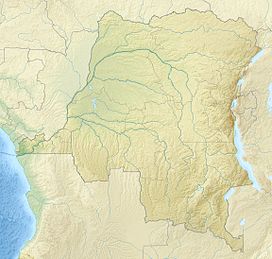- Mount Bisoke
-
Mount Bisoke  Rwanda/
Rwanda/ DRC
DRCElevation 3,711 m (12,175 ft) Location Range Virunga Mountains Coordinates 1°27′39″S 29°28′54″E / 1.46083°S 29.48167°ECoordinates: 1°27′39″S 29°28′54″E / 1.46083°S 29.48167°E Geology Type Stratovolcano Last eruption 1957 Mount Bisoke (also Visoke) is an Active volcano in the Virunga Mountains of the Great Rift Valley. It straddles the border of Rwanda and the Democratic Republic of the Congo, but the summit is located in Rwanda. It is located approximately 35 km northeast of the town of Goma and adjacent Lake Kivu.
Contents
Geology
Bisoke, like all of the peaks in the Virunga Mountain Range, is a volcano created by rift action on the forming divergent boundary which is slowly bisecting the African plate (see: Great Rift Valley). The mountain reached a height of 3,711 metres (12,175 ft) before becoming extinct. Bisoke has the largest crater lake of the range.
Geography
The mountain is located within Rwandan Volcanoes National Park and Congolese Virunga National Park. The steep slopes of the peak are densely covered with equatorial rainforest and alpine meadows. The summit does not gather snow, but is often shrouded in fog. Bisoke is one of the mountains considered a habitat for the Endangered mountain gorilla, and the Karisoke Research Center founded by Dian Fossey is located in the valley to the west.
Industry/Tourism
Being located within two national parks, it is by law off-limits to most standard wilderness industries such as logging, farming, or mining. Aside from visitors to the parks searching for gorillas or other wildlife, the peak is popular with mountaineers. It can be climbed in a day from the Rwandan side, and the Rwandan Tourist Board (ORTPN) leads two-day excursions to it and nearby Mount Karisimbi, most often out of the nearby city of Ruhengeri. The climb is considered steep, but walkable.[1]
The local tourism industry was devastated during the 1990s due to several bloody uprisings and wars in central Africa including the Rwandan Civil War (1990–1993), Rwandan Genocide (1994), First (1996–1997) and Second (1998–2003) Congo Wars, and Burundian Civil War (1993–2005). During this time, military action and refugee relocation wreaked ecological havoc (including deforestation and poaching of endangered species) upon the Volcanoes and Virunga National Parks, as well as the surrounding area. In recent years, both parks have been somewhat secured, and the tourism industry of the area has been recovering, despite ongoing conflicts.[2]
References
Categories:- Volcanoes of the Great Rift Valley
- Mountains of the Democratic Republic of the Congo
- Stratovolcanoes
- Virunga Mountains
- Volcanoes of the Democratic Republic of the Congo
- Extinct volcanoes
- Democratic Republic of the Congo–Rwanda border
- International mountains of Africa
Wikimedia Foundation. 2010.

